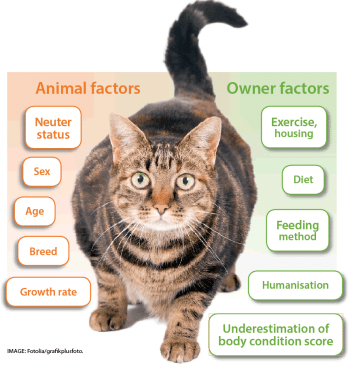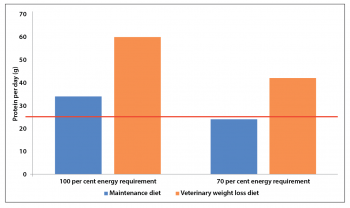20 Nov 2017
Cecilia Villaverde discusses why education, encouragement and ongoing support for owners is crucial for prevention and treatment.

IMAGE: Fotolia/Fabian Faber.
Obesity is a common disease in dogs and cats, with prevalence up to 60% depending on the study and geographical location1.
It is diagnosed using body condition score (BCS) scales. For example, in the 9-point BCS scale, 5 is ideal in cats (4 and 5 in dogs), while 6 to 7 indicates being overweight and 8 to 9 obese2,3.
Obesity is a risk factor for a variety of diseases in both species and can adversely affect quality of life. Moreover, in Labrador retrievers, it has been shown4 feeding a controlled amount of calories from weaning, to maintain a BCS of 4, resulted in a longer life compared to dogs from the same environment that ate the same diet, but were kept slightly overweight. These lean Labrador retrievers also showed lower prevalence of OA during their lives. Therefore, all efforts should be directed to educating owners to prevent and, if present, treat it.

A variety of risk factors exist, related both to the animal and owner1 (Figure 1). Animal-related factors are usually fixed, but owner-related factors can be addressed for prevention and treatment of the disease. One factor is the underestimation of BCS by the owner, which means he or she is not always aware of a problem with his or her pet’s weight.
Owner unawareness of pets’ obesity has been described in both dogs and cats, and can be very prevalent.
For example, one study found about 44% of owners of overweight dogs in Glasgow underestimated BCS5. Therefore, it is important to always let the owner know his or her pet has a BCS of 6 or higher after a physical exam, independently of the reason for the visit.
Once an owner knows his or her pet has an elevated BCS, he or she must be informed of the health risks associated with this disease and the potential effect of obesity on longevity. If an owner is not on board to tackle this problem, any further efforts – such as diet change and amount recommendations – are unlikely to be successful.
One study6 reported some owners of obese dogs could be sceptical of the diagnosis, which could be in response to a perceived accusation of wrongdoing – especially when informed of the negative consequences of a pet’s obesity. This stresses the importance of keeping communications regarding obesity non-judgemental, similar to those relating to any clinical condition.
The same study found owners of overweight dogs considered obesity to be associated with their pet’s desire for treats. In the author’s experience, some owners believe undergoing a weight loss plan would promote suffering in their pet, due to hunger and lack of treats, and may prefer their pet is “happy”, even if overweight and regardless of likely future negative effects.
It is important to present all owners with the realities of diseases associated with obesity, so they can make an informed decision. In cats, it has been reported calorie restriction can increase begging behaviour, but the authors also found cats were more affectionate towards their owners, so the “suffering” may be more perceived than real7. This may be another consequence of humanising our pets.
The use of over-the-counter maintenance diets for weight loss is not recommended – even “light” type diets.

Maintenance diets are formulated to meet nutrient needs when calorie needs are met; therefore, feeding restricted amounts of such a diet can result in nutrient deficiencies (Figure 2). Moreover, energy density of such diets can range widely and they are not necessarily less energy dense than some maintenance diets without weight management claims.
Veterinary weight loss diets from reputable brands are nutrient dense and can still meet nutrient requirements, even in the face of calorie restriction.
All nutrients are important – protein most of all. Ensuring protein is provided in sufficient amounts has been associated with decreased loss of lean body mass9 in cats, which could help prevent future weight regain.
One stumbling block to convince owners to embark on a weight loss plan using a veterinary diet is cost. One study10 in dogs compared the cost of feeding a weight loss veterinary diet in restricted amounts with a pre-weight loss feeding regime, and found weight loss using a veterinary diet was, on average, cost neutral. Owners may think it is more expensive because the bag is more expensive, but the difference disappears when feeding restricted amounts is considered.
Canned weight loss diets are more expensive, but can be helpful due to their increased bulk. Evidence also shows canned diets can be more satiating in cats11.
In cases where the pet is eating a special diet due to disease and cannot be changed, weight loss can be attempted, but at a slower rate.
Ideally, a thorough diet history should be obtained in all patients that require a weight loss plan (Figure 3).
It can be useful to have the owner write a food diary for a week and average a daily intake. This is especially useful in cases where the daily diet is changed often, and treats and table scraps are part of the diet.
Amounts should be detailed, ideally on a weight (grams or ounces) basis, since volume units are inexact. Once the daily energy intake is determined (true maintenance energy requirement), a good starting point is 80% of that value.
If figuring out energy intake is not possible, the use of formulas to calculate the initial energy allowance is indicated. A variety exist and can be completed with current bodyweight or ideal bodyweight, which is a more aggressive approach.
The author uses the resting energy requirement (RER) formula for dogs and 0.8 × RER for cats12:
70 × bodyweight (kg)0.75 ÷ kcal/day
These formulas have a high error associated, so this initial estimation is crude and requires follow-up to be adjusted.
Once the daily energy allowance has been determined, either by diet history or formula, the next decision is how many calories can be saved for treats. Some owners do not treat, but most do – so it is best to include in the regime, if this is the case, to promote compliance. Treats should be safe for dogs and cats, and should provide a maximum of 10% of the daily calories, with 90% provided by the weight loss diet. Some treats and their energy density are detailed in Panel 1 below.
The daily energy allowance – excluding treats – is then divided by the energy density of the chosen weight loss diet to obtain the grams per day to be fed. Using cups or other volume measures is inaccurate, especially in small pets that require lesser amounts of food, so owners should invest in kitchen scales if they do not own a set.
The diet should be fed in the specified amounts, since calorie control is key to the success of the plan.
In households with more than one person, one of them should be responsible for measuring the daily allowance of food each morning. This can be saved into a container, so if someone wants to treat or reward the pet, he or she can grab food from it – avoiding uncontrolled calorie provision.
Multiple daily feedings can help make the pet feel more sated and decrease begging. The use of food dispenser toys or strategies that promote the pet working for its food is highly recommended to reduce boredom.
A weight should be obtained at least every two weeks initially – every four weeks later on – to ensure weight loss is happening at the desired rate (1% to 2% bodyweight per week if using a weight loss diet, less than 0.5% if not). If these goals are not met and compliance is good, the food allowance needs to be adjusted up or down in 10% intervals.
Weigh-ins can be in person, or by telephone, email or text messaging. In-person visits are important to provide encouragement and troubleshoot issues, and a diet history should be taken at each recheck to check compliance.
Progress can be plotted in a graph, where the x axis is time (in weeks) and the y axis is weight. A horizontal line can be plotted to show the target bodyweight. This can be determined by previous weight history or the BCS – each point above 5 is a 10% to 15% excess bodyweight – although it is best to have the owners focus on the process rather than a number that can be inexact. Moreover, benefits can be seen with small weight loss percentages.
Follow-up is critical to success and the whole veterinary team is important for this – from frequent visit reminders and calls to check weights, to follow-up visits. This is a long process that can take up to, or more than, a year in some cases; therefore, constant encouragement and support for owners is essential.
Treat suggestions for owners to consider for dogs and cats undergoing weight loss plans include the following:
Banana – 89kcal/g
Apple (raw, no skin) – 48kcal/g
Watermelon (raw) – 30kcal/g
Green peas (canned) – 71kcal/g
Canned tuna in water – 86kcal/g
Baby carrots (raw) – 35kcal/g (4kcal/g-5kcal/g per carrot)
Cottage cheese (1% fat) – 72kcal/g
Turkey breast (deli) – 109kcal/g
Chicken breast (roasted, no skin) – 165kcal/g
Low-fat yogurt – 63kcal/g